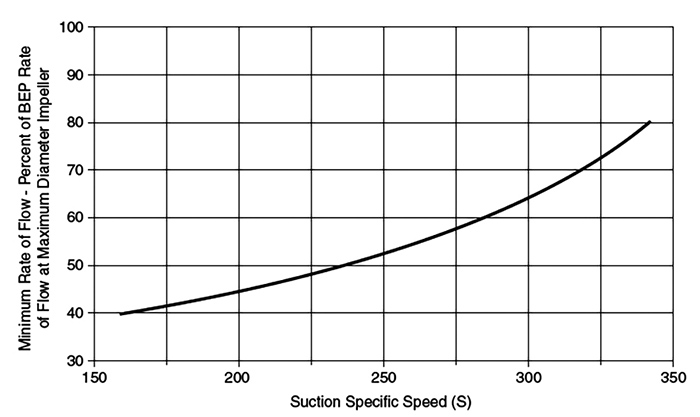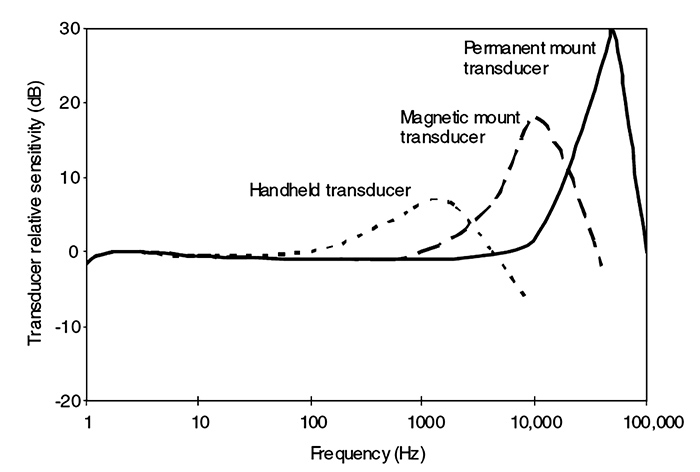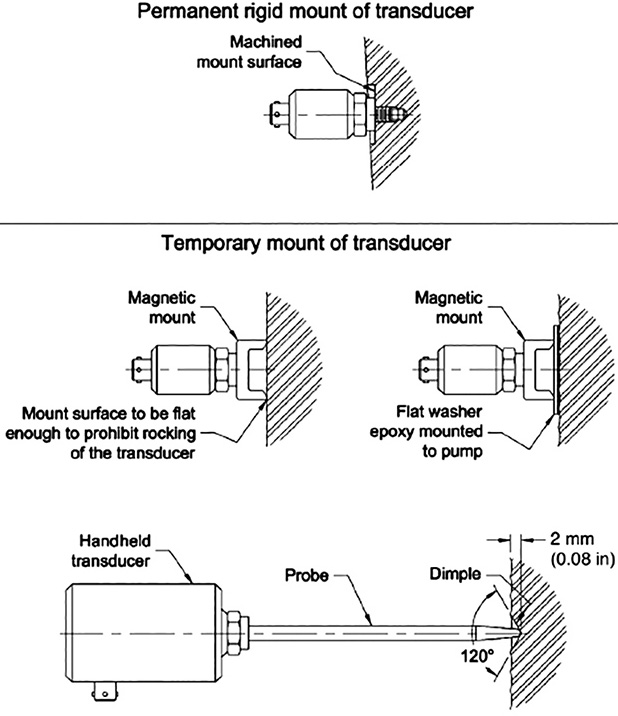Q:At what range outside the best efficiency point (BEP) will a pump begin to experience vibration? What consequences will occur from operating a pump away from BEP?
A: As flow is reduced below the BEP flow rate, the flow pattern through the pump changes and leads to a phenomenon known as suction recirculation. Suction recirculation occurs when the flow in the inlet area of the impeller separates from the vanes, forming recirculating eddies. These areas of non-uniform flow and uneven pressure distribution result in increased vibration of the pump rotor, cavitation damage to the impeller and excessive noise.
These effects increase as the rate of flow decreases, so the larger the deviation from the BEP, the more severe these effects. In addition, pumps with a higher suction specific speed design experience earlier and more intense suction recirculation than pumps with a lower suction specific speed design.
Figure 9.6.3.3.1.0a depicts the relationship between suction specific speed, rate of flow (percent of BEP), and the onset of suction recirculation and can be used as a guide to understand when vibration from this phenomena will begin to occur.
 Figure 9.6.3.3.10a. Estimated minimum rate of flow to avoid suction recirculation (metric units). (Graphics courtesy of Hydraulic Institute)
Figure 9.6.3.3.10a. Estimated minimum rate of flow to avoid suction recirculation (metric units). (Graphics courtesy of Hydraulic Institute)It should be noted that operating a pump away from the BEP, within reason, is acceptable. Most pumps can operate over a range of rates of flow to either side of the BEP within which the hydraulic efficiency and operational reliability are not substantially degraded. This range is known as the preferred operating region (POR). The POR is dependent on the pump specific speed and will narrow depending on the specific speed of the pump. Refer to ANSI/HI 9.6.3 Rotodynamic Pumps—Guideline for Operating Regions to determine the POR for your pump, and operate it within POR to limit vibration.
 Figure E.1 Transducer mounting relative sensitivity
Figure E.1 Transducer mounting relative sensitivityIThe allowable operating region (AOR) of a pump is a wider range of flow outside the POR over which the service life of a pump is shortened compared to when the pump is operated within the POR. Predicted bearing life will vary significantly over the AOR and can be considerably reduced, while noise, vibration and mechanical stresses are increased, therefore shortening the service life of a pump. The limits of AOR are determined by requirements other than energy consumption, and should be defined with the help of the pump manufacturer.
For more information on operating regions, refer to HI’s recently revised standard ANSI/HI 9.6.3 Rotodynamic Pumps—Guideline for Operating Regions at www.pumps.org.
Q: We recently installed a rotodynamic pump and want to monitor its vibration levels. What is the best method for monitoring vibration?
A: In order to accurately measure pump vibrations, selecting the appropriate vibration-measuring device and mounting that device properly is essential. Pump vibration levels are measured with vibration transducers, and for most stationary part diagnostic testing, accelerometer transducers are used. Accelerometer transducers are commonly based on piezoelectric transducers, which convert the vibration of the equipment under test into an electrical output that is proportional to acceleration. Accelerometers are made in a variety of frequency ranges and sensitivities, and it is important to select the correct combination to get accurate results.
The frequency range of an accelerometer transducer is determined by the mass and piezoelectric material selected, as well as the natural frequency of the device.
Transducer frequency ranges are classified as low frequency, general purpose and high frequency. Low frequency transducers are recommended for equipment operation at or below 600 rpm and can detect vibration to approximately 6 cycles per minute (cpm) or 0.1 hertz (Hz). Sensitivities for low frequency transducers should be 500 millivolts output signal per g of acceleration (mV/g) and above. General purpose transducers may be used for most equipment and provide a useful vibration range of approximately 180 to 600,000 cpm (3 to 10,000 Hz).
General purpose transducers should have a sensitivity range between 10 to 100 mV/g. High frequency transducers have a useful vibration range of 600 to 3,600,000 cpm (10 to 60,000 Hz) and are required for applications where the generated frequencies of the equipment are orders of magnitude above the rotating element speed. High frequency transducers should have a sensitivity range between 0.4 and 10 mV/g.
The type of mounting used for the vibration transducer can significantly affect the frequency response of the transducer.
Three typical categories of mounting are permanent rigid mount, magnetic mount and handheld transducer.
The permanent rigid mount offers the widest frequency range and is recommended for any installation requiring frequency measurement above 1 kHz. These types of mountings, especially when welded or mounted using a stud, result in the highest quality vibration readings.
The frequency range of both magnetic and handheld transducer mounting methods is significantly narrower compared to the frequency range of a permanent rigid mount.
If the mounting surface is sufficiently flat, magnetically mounted transducers provide a better frequency response than handheld transducers. Handheld transducers result in the poorest quality vibration reading because the readings are affected by the pressure applied by the person holding the transducer.
 Figure 9.6.4.2.2.2. Transducer mounting
Figure 9.6.4.2.2.2. Transducer mountingFigure 9.6.4.2.2.2 outlines the basic mounting methods for vibration transducers and Figure E.1 shows the transducer mounting relative sensitivity as a function of frequency.
For more information on vibration monitoring, refer to HI’s standard ANSI/HI 9.6.4 Rotodynamic Pumps for Vibration Measurements and Allowable Values and ANSI/HI 9.6.5 Rotodynamic Pumps Guideline for Condition Monitoring.


